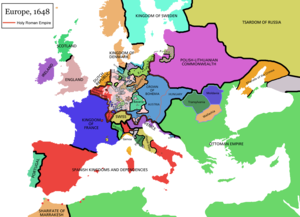
Back Dertigjarige Oorlog Afrikaans Dreißigjähriger Krieg ALS Guerra d'as Trenta Anyadas AN Þrittiggēara Orlege ANG حرب الثلاثين عاما Arabic حرب التلاتين سنه ARZ Guerra de los Trenta Años AST Otuzillik müharibə Azerbaijani اوتوز ایللیک ساواش AZB Утыҙ йыллыҡ һуғыш Bashkir
Peperangan Tiga Puluh Tahun (1618-1648) merupakan satu siri peperangan keagamaan yang sebahagian besarnya berlaku di kawasan yang kini dikenali sebagai Jerman yang turut melibatkan hampir kesemua kuasa-kuasa Eropah ketika itu. Konflik berpunca daripada pergeseran dan perbalahan di antara puak Katolik dan Protestan di wilayah-wilayah Empayar Suci Rom, tetapi kemudiannya menular menjadi satu perang politik besar yang menjerat keseluruhan benua Eropah. Peperangan ini dilihat sebagai kesinambungan daripada permusuhan di antara Perancis dan Habsburg bagi mengukuhkan kedudukan dan pengaruh kedua-duanya ke atas seluruh Eropah.
Kesan utama peperangan ini, yang kebanyakannya dilakukan oleh tentera upahan, ialah kemusnahan besar-besaran hampir keseluruhan wilayah yang terlibat. Ramai penduduk-penduduk di negeri-negeri Jerman, Negeri-Negeri Pamah dan Itali terkorban akibat kebuluran dan jangkitan penyaki, sementara negara-negara yang terlibat jatuh bankrap. Beberapa pergeseran yang mencetuskan peperangan ini terus tidak diselesaikan untuk tempoh yang panjang. Peperangan ini kemudiannya ditamatkan melalui Perjanjian Münster yang merupakan sebahagian daripada Perdamaian Westfalen.
Sepanjang peperangan ini, jumlah penduduk negeri-negeri Jerman berkurang sebanyak 30%. Di negeri Brandenburg, kehilangan nyawa dianggarkan hampir separuh, manakala di sesetengah tempat sehingga mencecah dua pertiga. Penduduk-penduduk lelaki bekurang sebanyak separuh. Di kawasan Czech pula sebanyak satu pertiga, akibat perang, penyakit, kebuluran dan pengusiran penganut Protestan. Tentera Sweden sendiri telah memusnahkan lebih 2,000 istana, 18,000 kampung dan 1,500 pekan d Jerman, iaitu satu pertiga daripada kesemua pekan yang wujud ketika itu.
- ^ 1625-1629. Bersepakat dengan Kuasa Katolik 1643-1645.
- ^ George Ripley, Charles Anderson Dana, The American Cyclopaedia, New York, 1874, p. 250, "...the standard of France was white, sprinkled with golden fleur de lis...". *[1]The original Banner of France was strewn with fleurs-de-lis. *[2]:on the reverse of this plate it says: "Le pavillon royal était véritablement le drapeau national au dix-huitième siecle...Vue du chateau d'arrière d'un vaisseau de guerre de haut rang portant le pavillon royal (blanc, avec les armes de France)."[3] from the 1911 Encyclopedia Britannica: "The oriflamme and the Chape de St Martin were succeeded at the end of the 16th century, when Henry III., the last of the house of Valois, came to the throne, by the white standard powdered with fleurs-de-lis. This in turn gave place to the famous tricolour."
- ^ Scores hungarians was fall into line with army of Gabriel Bethlen in 1620. Ágnes Várkonyi: Age of the Reforms, Magyar Könyvklub publisher, 1999. ISBN 963-547-070-3
- ^ 1911 Encyclopedia Britannica, entry National Flags: "The Austrian imperial standard has, on a yellow ground, the black double-headed eagle, on the breast and wings of which are imposed shields bearing the arms of the provinces of the empire. The flag is bordered all round, the border being composed of equal-sided triangles with their apices alternately inwards and outwards, those with their apices pointing inwards being alternately yellow and white, the others alternately scarlet and black ." Also, Whitney Smith, Flags through the ages and across the world, McGraw-Hill, England, 1975 ISBN 0-07-059093-1, pp.114 - 119, "The imperial banner was a golden yellow cloth...bearing a black eagle...The double-headed eagle was finally established by Sigismund as regent...".
- ^ Ervin Liptai: Military history of Hungary, Zrínyi Military Publisher, 1985. ISBN 963-326-337-9
- ^ Hussar (Huszár)
